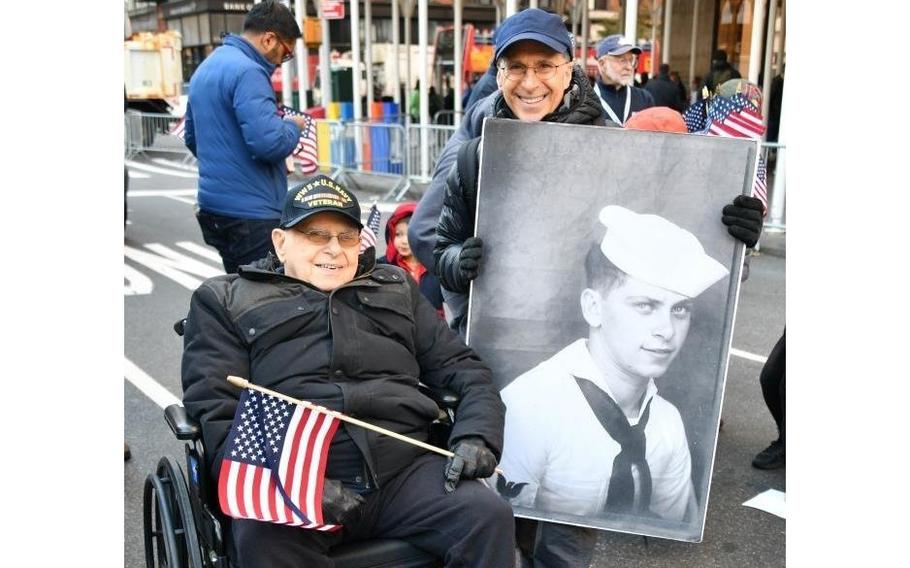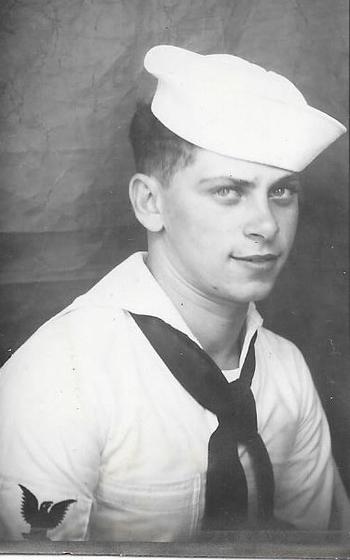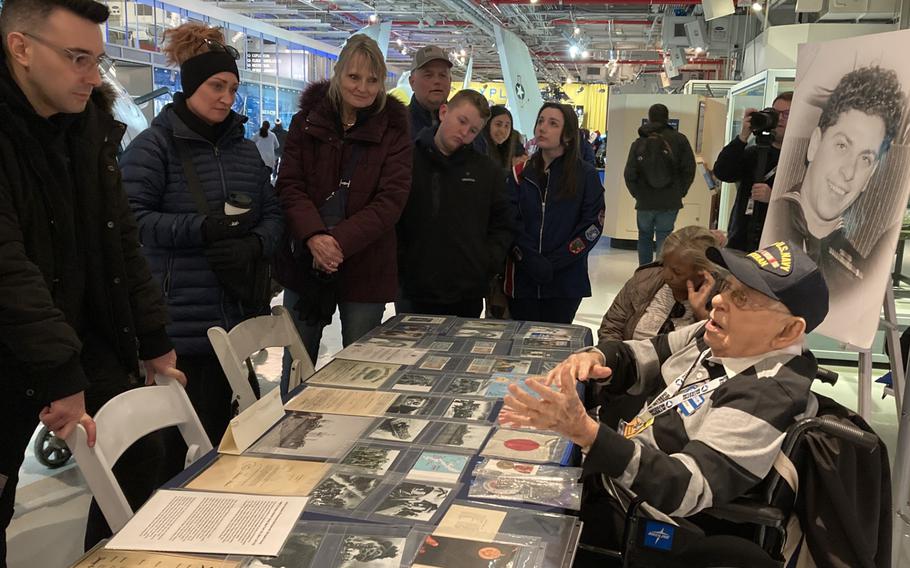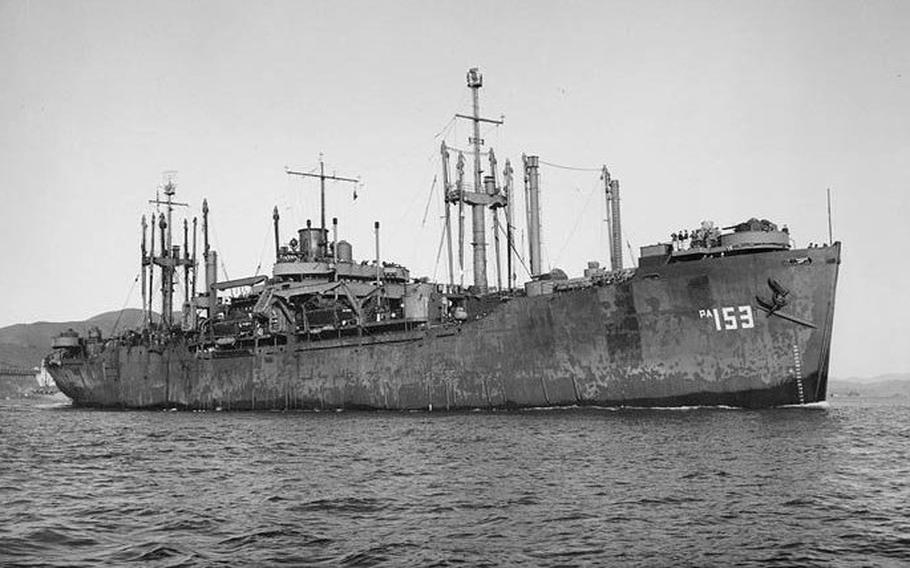
Navy veteran Arthur Grabiner is shown with his son, Douglas Grabiner, at the New York City Veterans Day parade on Nov. 11, 2023. Douglas Grabiner holds an oversized photo of his father in his Navy uniform. Arthur Grabiner, 98, participates in the parade annually with members of the USS Intrepid Former Crewmembers Association Inc. (USS Intrepid Former Crewmembers Association Inc.)
WASHINGTON — As an 18-year-old Navy yeoman 2nd class, Arthur Grabiner served during World War II aboard the USS Laurens, an attack transport ship that island-hopped and took part in amphibious assaults in the Pacific, including the battles of Okinawa and the Philippines.
He watched as a Japanese kamikaze suicide plane plunged into another ship and stood at attention during a mass burial at sea of fellow service members killed in the attack. At age 98, Grabiner is determined to devote this final chapter of his life to sharing memories of his wartime service.
“It’s a duty I owe this generation,” he said. “My hope for the future is that young people can learn something from my talks.”
On Monday — the 79th anniversary of Japan’s surrender — Grabiner will greet visitors at the Intrepid, a former World War II aircraft carrier transformed into a floating maritime museum permanently anchored in the Hudson River in New York City.
One of a fast-dwindling number of World War II veterans, Grabiner said he sees himself as having an important role in the commemoration. Less than 1% of the more than 16 million Americans who served in that war — or about 100,000 — were still alive at the beginning of this year, according to the National World War II Museum in New Orleans.
“At 98 years young, Dad is determined to remain active, vital and engaged while continuing to live his life purposefully. He will not allow age to define or limit him,” said his son Douglas Grabiner, who assists his father in public appearances at high school ROTC programs, military college commencements and special events at museums such as the Intrepid.

Arthur Grabiner joined the Navy when he was 18, serving aboard the USS Laurens in the Pacific theater during World War II. (Arthur Grabiner)
In June, Grabiner was invited to graduation ceremonies of the U.S. Merchant Marine Academy on Long Island, east of New York City.
“When Dad is out speaking in public, he acts like a gung-ho sailor back in the thick of things and eager to mix it up,” Douglas Grabiner said.
Grabiner’s story followed a template of millions of young Americans of the “Greatest Generation,” who came from modest origins but were thrust into extraordinary events at a young age.
The son of Polish immigrant parents, Grabiner (pronounced “Gruh-bee-ner”) said he’d rarely ventured more than 20 square blocks from his home in a working-class neighborhood of the Bronx before entering the Navy in 1944.
Assigned to the USS Laurens, which was commissioned in September 1944, Grabiner pulled overnight shifts as a watchman and assisted the gunners by relaying commands from officers on the bridge.
His ship operated out of New Guinea and New Caledonia transporting troops and supplies before landing soldiers on the main Philippine island of Luzon in January 1945.
Three months later, one of its sister ships, the USS Tyrrell, was attacked by Japanese aircraft off Okinawa. The aircraft failed to strike the ship but crashed alongside it and exploded, showering the deck with debris.
Grabiner participated in a burial at sea for fellow sailors the same day as the attack, describing it as the largest funeral that he ever attended.
Remains were placed in weighted canvas bags draped with the American flag in a mass funeral, he said. As a bugler played taps, the flag was removed, and the bag dropped into the ocean.
“Standing at attention and saluting while on the top deck of our respective ships, thousands of Navy sailors, myself included, watched as our brothers were buried at sea,” Grabiner said.

Arthur Grabiner, a former Navy yeoman 2nd class, served from 1944-1946. Grabiner, now 98, will bring his collection of World War II photos, documents and other artifacts to the Intrepid Museum in New York City on Monday, Sept. 2, 2024, to commemorate the 79th anniversary of the Japanese surrender. (Arthur Grabiner)
He and his shipmates were training for an invasion of Japan when they learned of the Aug. 6 atomic bombings of Hiroshima, which along with a second bombing of Nagasaki led to the Japanese surrender, ending World War II.
“The message told of a great bomb dropped on Japan that inflicted extraordinary damage. No mention was made of an atomic bomb,” Grabiner said.
The ship’s captain then received another radio message directing him to terminate the exercise and set sail for Pearl Harbor
“Dad believes his life was very likely spared by President (Harry) Truman’s order to drop the atomic bombs over Japan,” Douglas Grabiner said.
Grabiner returned to his family home in the Bronx after receiving an honorable discharge in May 1946. He went to college under the GI Bill, becoming a certified public accountant. He became a principal at a Manhattan public accounting firm, practicing for 50 years.
But Grabiner said his experiences from military duty have stayed with him and helped to shape his values.
“My service as a teenager in the U.S. Navy helped me appreciate that when we, as Americans, come together, we can accomplish anything. Not for self but for country,” he said. “I am proud to have played my part and grateful to those who do so today.”

Arthur Grabiner, a Navy veteran, served aboard the USS Laurens, shown here, during two years of active duty. The ship was part of a convoy that traveled together for self-protection across the Pacific theater in a zigzag formation to deter Japanese kamikaze pilots that targeted them. (Arthur Grabiner)